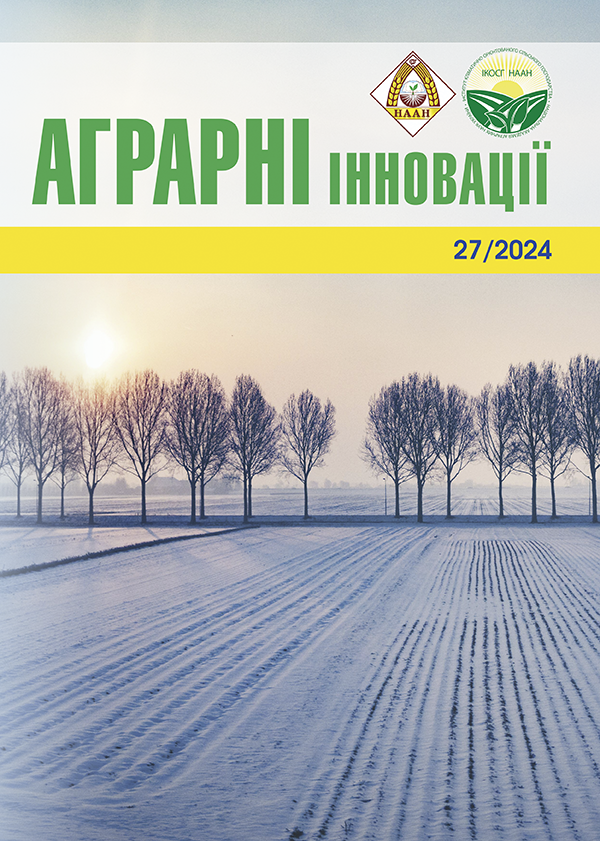PRODUCTIVITY OF CEREALS AND LEGUMES DEPENDING ON THE TECHNOLOGY OF CULTIVATION IN THE CONDITIONS OF THE STEPPE OF UKRAINE
Abstract
Purpose. To investigate the influence of technology of cultivation of cereals and legumes, on the example of winter and soybean wheat, on the productivity of the crops under study in the steppe of Ukraine. Methods. Field research was performed in accordance with modern requirements and standards of research business in agronomy and agriculture. Results. The best weather – climatic conditions for the formation of soybean productivity, including beans and seeds on one plant, were observed in 2023, especially for growing Bettina variety. Thus, depending on the study technology of cultivation on one plant of this variety, there were 17.6 – 41.3 beans and 44.1 – 128.0 seeds, which exceeded the performance of the fortress variety by 3.9 – 4.6 and 8.2 – 10.8%. The largest weight of 1000 seeds and seeds of soybean seeds, on average during the years of research, was for growing Bettina variety by no-till technology-respectively 131.4 and 15.4 g, which exceeded the indicators of other variants of the experiment, respectively by 13.1-27.8 and 3.9-11.7 g. no-till in 2024 received 1.08 t/ha of seeds, which exceeded the variant of classical technology of cultivation of culture by 0.18 t/ha or 16.7%. The same trend was observed in 2022 and 2023. Thus, the use of no-till technology was obtained respectively 1.9 and 2.2 t/ha of soybean seeds, which exceeded the variant of classical cultivation technology by 0.29-0.38 t/ha or 15.3-17.3%. Regardless of growing technology in all years of research, a slightly higher yield was formed by plants of Bettina variety. The use of resource-saving technology for the cultivation of winter Mzuri-ProTil wheat has a positive impact on the formation of culture productivity. On average, during the years of research, the use of Mzuri-ProTil technology for winter wheat helped to increase the amount of grains in the spikelets by 6.5 pcs, and the mass of 1000 grains by 6.9 g compared to the variant of classical winter wheat technology. In more favorable weather conditions of 2022-2023, winter wheat plants by Mzuri-ProTil technology were formed 7.10 t/ha of grain, which exceeded the variant of classical technology by 11.3%. The use of Mzuri-ProTil technology in arid conditions of 2023-2024 provided yields at 4.78 t/ha, which exceeded the grain yield rates by classical growing technology by 12.8%. Conclusions. In the conditions of the Steppe of Ukraine, as a result of field studies in 2022-2024, the positive impact of resource and soil-saving technologies for cultivation of grain and legumes was proved. On average, during the years of research and the variety, the most beans and seeds from one soybean plant were noted for the use of no-till technology-38.1 and 107.9 units respectively, which was higher than the variant of classical cultivation technology, respectively by 21.9 and 70.2 pcs. The yield of soybean when growing by no-till technology, on average during the years of research and by factor variety, amounted to 1.73 t/ha, which exceeded the indicators of the variant of classical technology by 0.29 t/ha or by 16.8%. The use of Mzuri- ProTil technology for winter wheat helped increase the amount of grains in the spikelets by 14.4%, the mass of 1000 grains by 16.0%, and grain yield-by 11.9%compared to classical crop technology.
References
2. Lamichhane J. R., Constantin J., Schoving C., Maury P., Debaeke Ph., Aubertot J.-N., Dürr C. Analysis of soybean germination, emergence, and prediction of a possible northward establishment of the crop under climate change. European Journal of Agronomy. 2020. 113.
3. Каленська С. М., Новицька Н. В. Ефективність нанопрепаратів у технології вирощування сої. Plant and Soil Science. 2020. 11(3). С. 7–21. https://doi. org/10.31548/agr2020.03.007
4. Eco-balancing of arable farming as a first step to organic manufacturing of plant growing products / Pysarenko V. M., Kovalenko N. P., Pospielova G. D., Pischalenko М. А., Melnychuk V. V., Sherstiuk E. L. Bulletin of Poltava State Agrarian Academy. 2020. №3. 109 –117. https://doi.org/10.31210/visnyk2020.03.12
5. Дідора В. Г. Симбіотична продуктивність сої залежно від інокуляції насіння та удобрення. Scientific Horizons. 2018. № 1 (64). С. 23-28.
6. The role of winter wheat plant height in the formation of grain yield depending on varietal characteristics and weather conditions / Korkhova M., Drobitko A., Panfilova A., Smirnova I. Scientific Horizons. 2022. 25(11). 41-50.
7. Fungicidal protection of soy crops against root rot / Pospielova G., Kovalenko N., Nechiporenko N., Kocherga V., Grechkosiy A., Skliar S. Scientific Progress & Innovations. 2023. 26 (3). 5–10. https://doi. org/10.31210/spi2023.26.03.01
8. Сучасне виробництво сої як елемент розвязання проблеми харчового білка: світові тренди та вітчизняні реалії / Жуйков О. Г., Іванів М. О., Марченко Т. Ю., Возняк В. В. Таврійський науковий вісник. 2020. № 116. Ч. 1. С. 54 – 63.
9. Зв'язок структурних елементів інтродукованих зразків сої (Glycine Max. L.) з продуктивністю насіння в умовах зрошення півдня України / Вожегова Р. А., Боровик В. О., Клубук В. В., Марченко Т. Ю. Генетичні ресурси рослин. 2018. № 22. С. 11-18.
10. Effect of seed inoculation and foliar fertilizing on structure of soybean yield and yield structure in western polissya of Ukraine / Novytska N., Gadzovskiy G., Mazurenko B., Svistunova I., Martynov O. Agronomy Research. 2020. № 18 (4). Р. 2512–2519.






